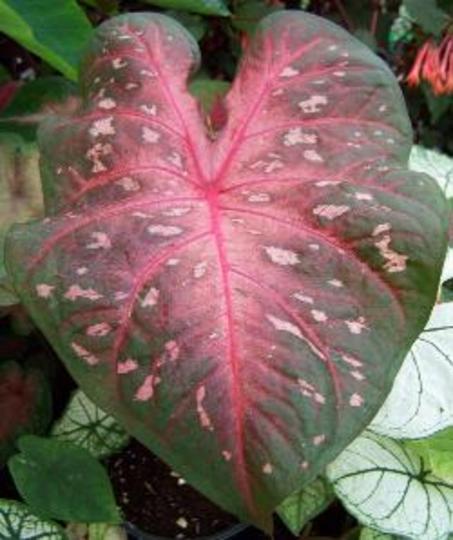Colorful Tropical Foliage Plants – Croton Plants And Caladium Plants
2 comments
Codiaeum variegatum, also called “Garden Croton” or “Variegated Croton”, is a species of plants in the genus Codiaeum, a member of the Euphorbiaceae family.
These colorful tropical foliage plants look great when grown in pots and grouped together with other tropical plants, including dwarf bananas, bromeliads, gingers, gardenias, small heliconias, hibiscus, jasmine, orchids or plumeria plants.

Croton plants are known for their colorful foliage which has a waxy texture with vertical growth and leaves facing outwards. The more sun or bright light Croton plants receive, the more colorful their foliage becomes.
Crotons need to be watered well with the soil remaining moist. They prefer to be grown in high humidity and benefit from daily misting when the humidity is low.
When fertilizing Croton plants any fertilizer high in Nitrogen, like 9-3-6 is recommended.
Crotons belong to the family of Euphorbiaceae and are therefore considered poisonous. The sap may cause skin eczema and is also toxic if ingested.
Popular varieties of these colorful tropical foliage plants include Codiaeum variegatum ‘Gold Moon’, Codiaeum variegatum ‘Gold Sun’, Codiaeum variegatum ‘Goldfinger’, Codiaeum variegatum ‘Grubell’, Codiaeum variegatum ‘Petra’ and Codiaeum variegatum ‘Excellent’.
Croton plants, when grown outdoors, have to be protected or brought indoors if the temperature drops below 50 degrees Fahrenheit or 10 degrees Celsius. Otherwise leaf drop may occur.
Another great group of colorful tropical foliage plants are Caladiums. Caladium is one genus of plants in the Araceae family.

Currently there exist over 1000 cultivars of Caladium bicolor which is considered the original Caladium from South America.
Caladium plants have been cultivated in Europe since the eighteenth century.
Popular varieties of these colorful tropical foliage plants include Candidum White, Cardinal Red, Carolyn Wharton Pink, Fannie Munson Pink, Frieda Hemple Red, Postman Joyner Red, Roselight Pink, White Queen and Rojo Red, to name a few.
Croton and Caladium plants can be grown outdoors during the warmer months of the year and indoors as house plants the rest of the year.

Caladium plants are only hardy in zone 9 and 10. In colder regions they have to be dug up in fall. They also make great house plants year round.
While actively growing Caladium plants need a great deal of moisture and should not be allowed to dry out.
As with Croton plants it’s best to use a fertilizer high in Nitrogen, like 9-3-6 and mist their foliage daily if the humidity is low.
All parts of Caladium plants are considered poisonous and may cause skin irritations in sensitive individuals.
I hope you’re already enjoying your Croton and Caladium plants. If not, give them a try and brighten up your plant stand indoors or add that needed color to your outdoor garden.
Copyright © Bob Walsh
 14 Aug, 2011
14 Aug, 2011 2 likes
2 likes
Previous post: Growing Plumeria Cuttings And Plumeria Plants With The Egg Method
Next post: Slideshow - How To Plant Plumeria Cuttings
Comments
Although I've never grown these lovely plants I have admired them for many years.
Thanks for such an interesting blog, Bob! This is going into my favourites! :-))
21 Aug, 2011
Recent posts by bobwalshplumerias
- Plumeria Frangipani Plants and Their History
2 Aug, 2013
- Video of Plumeria Flowers in Chicago - Plant Hardiness Zone 5
20 Mar, 2013
- Mystery Plumeria
13 Feb, 2013
- Plumeria 'Kauka Wilder'
16 Jan, 2013
- Plumeria obtusa 'Singapore' and Plumeria obtusa 'Dwarf Singapore Pink'
21 Jul, 2012
- Purchasing Plumeria Cuttings Plants And Seedlings On eBay
4 Jul, 2012
Members who like this blog
-
Gardening with friends since
9 Aug, 2009 -
Gardening with friends since
4 Apr, 2009


Thank you for the time and effort put in to this blog.Both Croton and Caladium are grown at Kew Gardens and are very popular with the public.
16 Aug, 2011